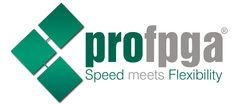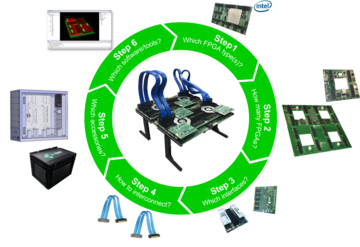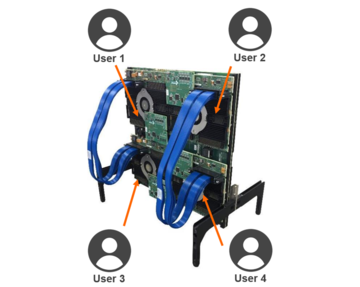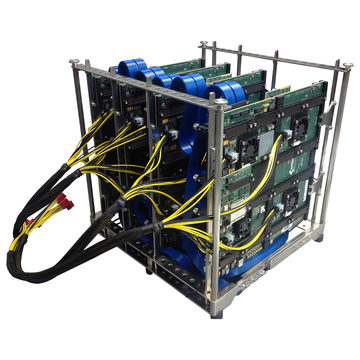Concept of ASIC Prototyping Solution
Multi-FPGA based ASIC Prototyping
Concept of the proFPGA Product Family
The proFPGA product family is a complete and modular multi FPGA solution, which meets highest requirements in the area of FPGA based Prototyping.
The proFPGA product series consists of three types of motherboards (uno, duo, quad), different kinds of FPGA Modules (Xilinx Virtex® UltraScale+™, Xilinx Virtex® UltraScale™, Xilinx Virtex® 7, Xilinx Zynq™, Xilinx Zynq™ UltraScale+™, Intel® Stratix®, Intel® Arria®), a set of interconnection boards/cables, and various daughter boards like DDR3/DDR4 memory boards or high speed interface boards like PCIe gen3, QSFP28 or USB 3.0.
It addresses customers who need a scalable and flexible high speed ASIC Prototyping and IP verification solution for early software development and real time system verification. The innovative system concept and technologies offer highest flexibility and reusability for several projects, which guarantees the best return on invest.
proFPGA Parallel Use Mode
The FPGA Prototyping Platform proFPGA can be divided into configurable virtual sub-systems. The proFPGA Parallel Use Mode is supported by single-motherboard and multi-motherboard systems.
In addition, exclusive and shared motherboard resources such as clocks and sync events are available. This mode enables a concurrent and independent access to each sub-system. Therefore, each sub-system can be independently configured, booted up or shut down, controlled and monitored.
Another feature of the proFPGA Parallel Use Mode is that concurrent running host applications are able to access the same sub-system. In addition, a safty mechanism is built-in to protect sub-systems from dead locks and disturbances.
Highest FPGA Flexibility in ASIC Prototyping
ASIC Prototyping refers to application-specific integrated circuit.
The system architecture is based on a modular and scalable system concept. The FPGAs are assembled on dedicated FPGA modules, which will be plugged on the proFPGA uno, duo or quad motherboard. This offers the highest flexibility on the market. For example, you can use different FPGA types in one system or scale your system in increments of one FPGA.
The user has nearly 100% access to all available I/Os of the FPGA, which gives him maximum flexibility regarding the FPGA interconnection structure. This way the prototyping system can be adapted in the best way to any user design. Furthermore, the system offers a total of up to 64 extension sites on the top and bottom site of each quad motherboard for standard or user specific extension boards like DDR4 memory, PCIe gen1/2/3, QSFP28, USB 3.0 or other high performance interface and interconnection boards. The system can be scaled horizontally and vertically, by connecting boards side by side or stacking several boards on top of each other in a rack.
We offer a great variety of Multi-FPGA Prototyping Products.
Biggest ASIC Prototyping Capacity
Equipped with up to 4 Xilinx Virtex® UltraScale+™ VU19P FPGA modules, the proFPGA quad system can handle up to 192 M ASIC gates on only one board (with 4 Intel® Stratix® 10 GX 10M FPGA modules even up to 240M ASIC gates). Due to the fact, that multiple proFPGA quad or duo systems (up to 9) can be connected to an even larger system, there is a maximum capacity of 1728 M ASIC gates (Xilinx) respectively 2160 M ASIC gates (Intel).
Best in Class Expandability
The modular concept allows an easy expansion of the system capacity by adding additional FPGA modules. Besides, users can create project specific prototypes in the quickest and easiest way. Interface, memory, or customer specific application boards can simply be plugged as daughter cards on the extension sites of the proFPGA system.
Maximum Routing Flexibility
The open system architecture makes nearly all FPGA I/Os available to the user and enables highest interconnection flexibility between all FPGAs and extension sites. It assists in adjusting the connection architecture to the design in the best possible way.



